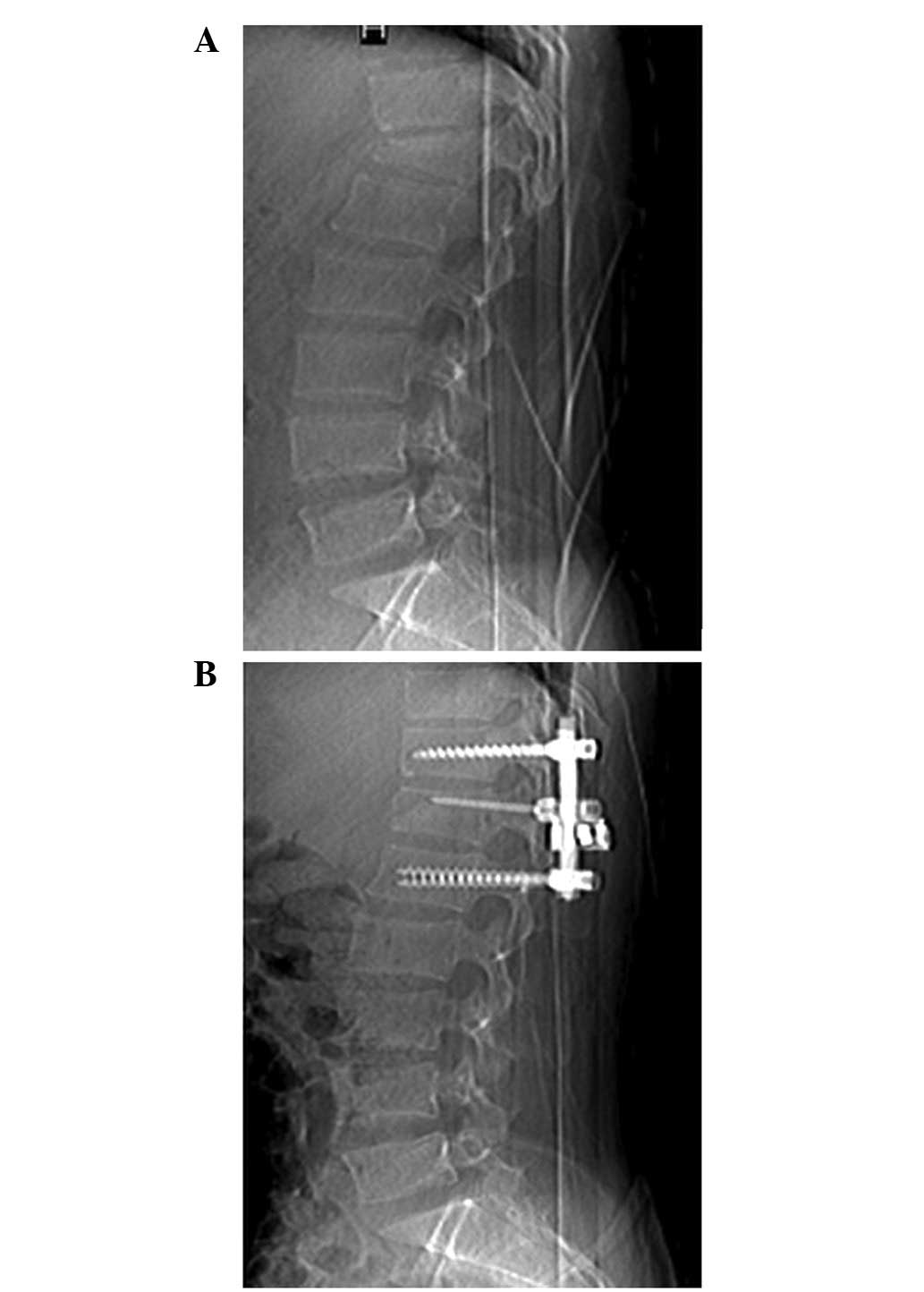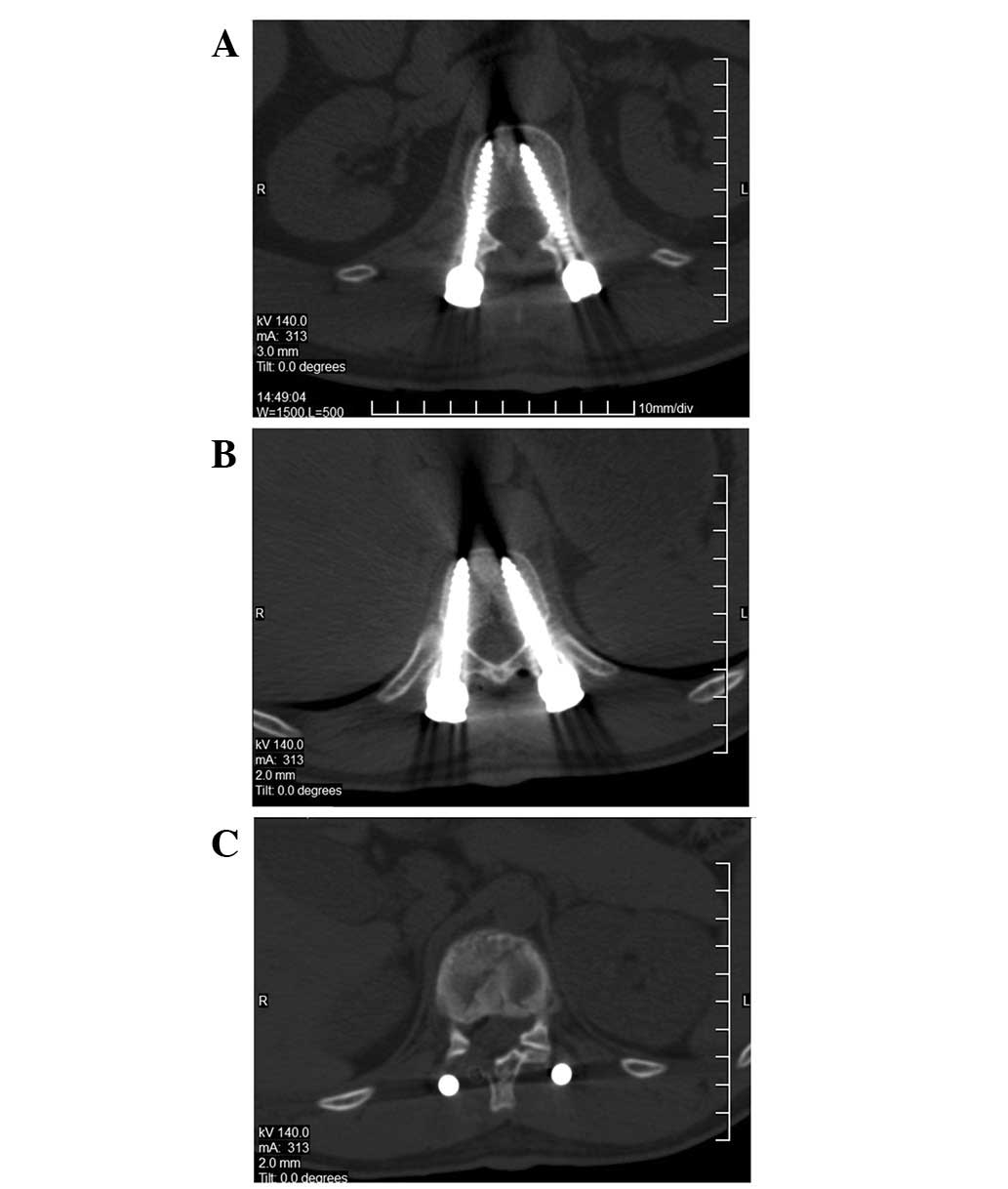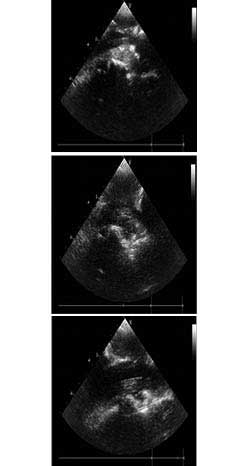|
1.
|
Bohlman HH, Kirkpatrick JS, Delamarter RB
and Leventhal M: Anterior decompression for late pain and paralysis
after fractures of the thoracolumbar spine. Clin Orthop Relat Res.
300:24–29. 1994.PubMed/NCBI
|
|
2.
|
Eberl R, Kaminski A, Müller EJ and Muhr G:
Importance of the cross-sectional area of the spinal canal in
thoracolumbar and lumbar fractures. Is there any correlation
between the degree of stenosis and neurological deficit? Orthopade.
32:859–864. 2003.(In German).
|
|
3.
|
Xu BS, Tang TZ, Ni CF, Yang HL, Xu YZ and
Bao ZH: Clinical application of short-segment pedicle instrument
and vertebroplasty for thoracolumar fractures. Chinese Journal of
Trauma. 5:264–266. 2003.
|
|
4.
|
McDonough PW, Davis R, Tribus C and
Zdeblick TA: The management of acute thoracolumbar burst fractures
with anterior corpectomy and Z-plate fixation. Spine. 29:1901–1908.
2004. View Article : Google Scholar : PubMed/NCBI
|
|
5.
|
Heary RF, Salas S, Bono CM and Kumar S:
Complication avoidance: thoracolumbar and lumbar burst fractures.
Neurosurg Clin N Am. 17:377–388. 2006. View Article : Google Scholar : PubMed/NCBI
|
|
6.
|
Dai LY, Jiang LS and Jiang SD:
Anterior-only stabilization using plating with bone structural
autograft versus titanium mesh cages for two- or three-column
thoracolumbar burst fractures: a prospective randomized study.
Spine (Phila Pa 1976). 34:1429–1435. 2009. View Article : Google Scholar
|
|
7.
|
Radcliff K, Kepler CK, Rubin TA, et al:
Does the load-sharing classification predict ligamentous injury,
neurological injury, and the need for surgery in patients with
TBFs?: Clinical article. J Neurosurg Spine. 16:534–538. 2012.
View Article : Google Scholar : PubMed/NCBI
|
|
8.
|
Kim MS, Eun JP and Park JS: Radiological
and clinical results of laminectomy and posterior stabilization for
severe thoracolumbar burst fracture: surgical technique for
one-stage operation. J Korean Neurosurg Soc. 50:224–230. 2011.
View Article : Google Scholar : PubMed/NCBI
|
|
9.
|
Standard for neurologic and functional
class of spinal cord injury. Chicago: American Spinal Injury
Association; 1992
|
|
10.
|
Lu FF, Chen Q, Zhong SY, et al: Precise
localization of glial scar boundary in chronic spinal cord injury
in dogs. Chinese Journal of Neurology. 5:489–492. 2009.
|
|
11.
|
Li Q, Liu Y, Chu Z, Chen J and Chen M:
Treatment of thoracolumbar fractures with transpedicular
intervertebral bone graft and pedicle screws fixation in injured
vertebrae. Zhongguo Xiu Fu Chong Jian Wai Ke Za Zhi. 25:956–959.
2011.(In Chinese).
|
|
12.
|
Alpantaki K, Bano A, Pasku D, et al:
Thoracolumbar burst fractures: a systematic review of management.
Orthopedics. 33:422–429. 2010. View Article : Google Scholar : PubMed/NCBI
|
|
13.
|
Parker JW, Lane JR, Karaikovic EE and
Gaines RW: Successful short-segment instrumentation and fusion for
thoracolumbar spine fractures: a consecutive 41/2-year series.
Spine (Phila Pa 1976). 25:1157–1170. 2000.PubMed/NCBI
|
|
14.
|
Marco RA, Meyer BC and Kushwaha VP:
Thoracolumbar burst-fractures treated with posterior decompression
and pedicle screw instrumentation supplemented with
balloon-assisted vertebroplasty and calcium phosphate
reconstruction. Surgical technique. J Bone Joint Surg Am. 92:67–76.
2010.
|
|
15.
|
Mohanty SP, Bhat SN and Ishwara-Keerthi C:
The effect of posterior instrumentation of the spine on canal
dimensions and neurological recovery in thoracolumbar and lumbar
burst fractures. Musculoskelet Surg. 95:101–106. 2011. View Article : Google Scholar : PubMed/NCBI
|
|
16.
|
Liao JC, Fan KF, Keorochana G, Chen WJ and
Chen LH: Transpedicular grafting after short-segment pedicle
instrumentation for thoracolumbar burst fracture: calcium sulfate
cement versus autogenous iliac bone graft. Spine (Phila Pa 1976).
35:1482–1488. 2010.
|
|
17.
|
Afzal S, Akbar S and Dhar SA: Short
segment pedicle screw instrumentation and augmentation
vertebroplasty in lumbar burst fractures: an experience. Eur spine
J. 17:336–341. 2008. View Article : Google Scholar : PubMed/NCBI
|
|
18.
|
Li Q, Li XZ, Liu Y, et al: Treatment of
thoracolumbar fracture with pedicle screws at injury level: a
biomechanical study based on three-dimensional finite element
analysis. Eur J Orthop Surg Traumatol. Sep 19–2012.(Epub ahead of
print).
|
|
19.
|
Jindal N, Sankhala SS and Bachhal V: The
role of fusion in the management of burst fractures of the
thoracolumbar spine treated by short segment pedicle screw
fixation: a prospective randomised trial. J Bone Joint Surg Br.
94:1101–1106. 2012.PubMed/NCBI
|
|
20.
|
Ugras AA, Akyildiz MF, Yilmaz M, Sungur I
and Cetinus E: Is it possible to save one lumbar segment in the
treatment of thoracolumbar fractures? Acta Orthop Belg. 78:87–93.
2012.PubMed/NCBI
|
|
21.
|
Eno JJ, Chen JL and Mitsunaga MM: Short
same-segment fixation of thoracolumbar burst fractures. Hawaii J
Med Public Health. 71:19–22. 2012.PubMed/NCBI
|
|
22.
|
Riaz-ur-Rehman, Azmatullah, Azam F,
Mushtaq and Shah M: Treatment of traumatic unstable thoracolumbar
junction fractures with transpedicular screw fixation. J Pak Med
Assoc. 61:1005–1008. 2011.PubMed/NCBI
|
|
23.
|
Ge CM, Wang YR, Jiang SD and Jiang LS:
Thoracolumbar burst fractures with a neurological deficit treated
with posterior decompression and interlaminar fusion. Eur Spine J.
20:2195–2201. 2011. View Article : Google Scholar : PubMed/NCBI
|
|
24.
|
Yang W, Zhao X, Wang Q, et al: Application
of the real-time monitoring with ultrasonography in the vertebral
and spinal cord operation. Chin J Med Ultrasound. 12:2139–2142.
2010.
|
|
25.
|
Mavrogenis A, Tsibidakis H, Papagelopoulos
P, et al: Posterior transpedicular decompression for thoracolumbar
burst fractures. Folia Med (Plovdiv). 52:39–47. 2010.PubMed/NCBI
|
|
26.
|
Marino RJ, Ditunno JF Jr, Donovan WH and
Maynard F Jr: Neurologic recovery after traumatic spinal cord
injury: data from the Model Spinal Cord Injury Systems. Arch Phys
Med Rehabil. 80:1391–1396. 1999. View Article : Google Scholar : PubMed/NCBI
|

















